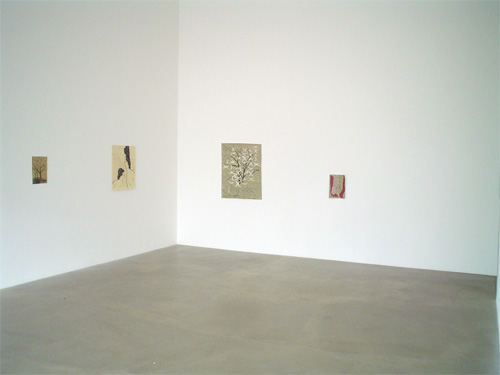

This webpage won't be updated anylonger.
Please visit: www.gerhardsengerner.com
![]()

Installation view, Kerstin Cmelka, c/o – Atle Gerhardsen, 2004

Installation view, Dirk Fleischmann, c/o – Atle Gerhardsen, 2004

Installation view, Jay Chung und Q Takaki Maedao, c/o – Atle Gerhardsen,
2004

Installation view, Shannon Bool, c/o – Atle Gerhardsen, 2004
SHANNON BOOL
JAY CHUNG
KERSTIN CMELKA
DIRK FLEISCHMANN
Q TAKEKI MAEDAO
Opening reception: Jul 3. 2004, 6 p.m.
Duration: Jul 3.–Jul 31. 2004
It is a great pleasure to announce a group show by five young artists from
Städelschule Frankfurt.
The aesthetic of so called Paparazzi-Photos, focussing the action and recognizability
of a prominent person, disregarding quality, has been point of origin for
Kerstin Cmelka’s work O.T. (Fly-Posting). Concentrating on pictures
of prominent mothers, showing the multiple role of being emancipated, autonomous
and successful as well as a careful mother and wife, Kerstin Cmelka assumes
and re-enacts certain gestures, movements, actions, places or clothes showing
herself in the role of an observed star. The photographs produced as posters
had been illegally fixed up in the city of Frankfurt. The effect of being
integrated in local poster advertising and the transformation of the works
during the time had also been part of the work documented and shown in six
photographs.
Most of the projects of Dirk Fleischmann last for very long time periods.
Since 2002 Fleischmann maintains a little chicken farm at a school for disabled
children in Frankfurt am Main with the title “Free range chicken eggs
from chicken, that live in a coop based on a plan by Rosemarie Trockel”.
The slide-installation “One hundred and sixty out of two billion eggs”
consists of a series of slides of 160 different eggs, that were produced in
Fleischmanns chicken farm within a time period of two and a half months. The
title “One hundred and sixty out of two billion eggs” relates
these eggs to the amount of all eggs being produced within the same time period
in Germany.
Modus Tollens consists of two photographs documenting the two months Jay Chung
and Q Takeki Maeda spent under the false impression that they would never
see each other again: “We intentionally acted as if Maeda was obligated
by circumstances so embarrassing that not only would he be forced to return
to Japan permanently, but he would also have to break contact with his friends
and colleagues. As Maeda preferred to leave in secret, only I knew of his
departure, one month in advance, which we tried to spend accordingly. Then,
starting from the day of his departure (the day the first photo was taken),
as it was clear he would not depart, we began to do it again.”
The video Untitled shows two figures appearing, fighting and disappearing
as a shadow play, which occurs on top of the shadow in front of a car driving
on a highway.
The idea for Shannon Bools drawings came originally from the famous case study
"the wolfman" by Freud. In this study, the patient's obsessive-compulsive
disorder was traced back to a nightmare he had, where he dreamt he had woken
up, looked out of his window at a walnut tree in his garden, and then had
seen "six or seven wolves," all white, staring at him. Freud interpreted
this dream in about 50 different ways; the patient's drawing of the dream
first fascinated him, where he only drew 5 of the 6 or 7 wolves. Freud first
associated this dream with a number of fairy tales (the wolf and the seven
little kids, little red riding hood, the tailor and the wolf) and then through
further analysis determined that the wolves could have represented a scene
of his parents having sex that the patient had witnessed when he was very
small. The patient later claimed, that the attentive gaze of the wolves was
his, freud wrote 'in the one case distortion consists in the exchange of subject
and object, active and passive modes, being watched instead of watching".
In the essay "1914, One or Several Wolves" Deleuze and Guattari
dismiss freud's entire interpretation of the number of wolves and determine
that the question of the wolves – and their number – is not one
of representation and wrote "don't think for a minute that it has to
do with believing oneself a wolf, representing oneself as a wolf. The wolf,
wolves are intensities, speeds, temperatures, nondecomposable variable distances.
A swarming, a wolfing...Lines of flight of deterritorialization, becoming-wolf,
becoming inhuman, deterritorialized intensities:that is what multiplicity
is." The ideas in these texts, specifically the multiplicity in attempts
to read reality, were the starting point for Shannon Bools works, where she
plays with space within its relation to representational content and subjective
readings of reality.